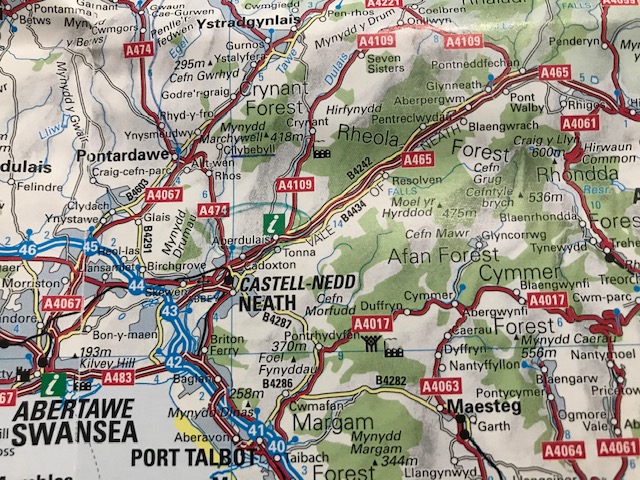Footsteps-Introduction.
- On Mar, 12, 2021
- Helen & Allen
- Around Tan yr Eglwys, Local Walks, Location

In Search of Footsteps and Pathways – A General Introduction.
Within our area of Neath and Port Talbot Borough Council close to Tan yr Eglwys Cottages there are numerous opportunities to walk along local footpaths. Local residents over centuries have created these pathways. This small county area stretches across the Tawe, Nedd and Afan valleys. The rivers flow down each valley to reach the sea at Swansea, Neath and Port Talbot. All levels of walks can be found. There are gentle ambles from the door to more challenging routes available. Surrounded by breathtaking scenery, there are walks to suit all abilities.
It is interesting to look beyond the current path ways, and to consider why the tracks first developed? In each instance there are tales to hear that in turn unlock the history of each valley. Discover the past inhabitants of each area over the centuries. There is a reason for the existence of each footpath and often accompanied by a tale of hardship. The history is fascinating and there are surprises as to the people that have lived here in the past. It is possible to discover the many industries that have existed here in these unexpected places. Come to enjoy the paths and appreciate the rich heritage of these hills and valleys.
The Swansea Valley
The Swansea valley through which the Tawe river runs. Where Pontardawe is situated had good coal reserves on the steep sides of the valley. There were numerous small mines and the coal was carried by canal barges and then later by the railway to power local heavy industries or generally exported from Swansea Docks. Wood was carried also from the deciduous woodland for use as pit props further afield. Heavy industries became established on the valley floor, tin plate and steelworks dominated these landscapes and communities, to a degree that we now fail to imagine.
The Neath Valley
The Neath valley through which the River Nedd and its tributaries flow also had coal reserves. As well as silica and gunpowder industries. At the surface of the steep banks of the Mellte, Nedd Fechan and the Sychryd valleys, the veins of coal give way to exposed beds of silica rock. During the 18th – 20th Centuries, the area around Pontneddfechan mined and transported this commodity throughout the world. The original local demand was for creating heat resistant bricks to line the copper and iron smelting furnaces. The bricks made from almost all pure silica were highly sought after because they withstood the high furnace temperatures without shattering.
Tramways were constructed to carry the silica out of the barely passable gorges. These pathways have developed into the the numerous footpaths which now allow visitors to see the spectacular waterfalls. The canals, railways and deep river bed allowed goods to then be transported further afield from the docks at Swansea and Briton Ferry. Pontneddfechan also became an important place for the production of gunpowder, the geography of the small steep sided tributaries being ideal.
The Afan Valley
The Afan valley runs inland from Port Talbot, yet again another valley with rich coal reserves. Echoing the history of the adjoining valleys, the industrial revolution both exploited the resources available and subsequently left large scars on the surrounding countryside. Copper and tinplate works, blast furnaces, rolling mills and coke ovens dominated the landscape. Airborne pollution from these heavy industries inhibited the growth of vegetation on the surrounding hillsides for numerous decades. The steep sides soar above the wide tarmaced pathway. Much of the hillsides were planted post war with larch, spruce and pine.
Currently there are large bare areas, some harvested for the wood source others felled for disease prevention. Whilst the topography of the upper level has endeared itself to mountain bike trails, the disused tracks of the railway that once transported products from these industrial communities now provide superb walking and cycling routes that gently climb upwards along the valley floor.
Who else has walked these valleys?
In addition to the paths along the old railway tracks, canal tow paths, local parish paths there are the routes that were created by workmen trampling the route to work. The paths to the parish church have been trodden since the eleventh century. A visit to Banwen can provide the landscape that existed at the time of the Roman occupation, you can also learn of the possible connection of St Patrick to the area. Follow the valley down to Neath and evidence of the Cistercian monks can be seen at Neath Abbey and also over at the Abbey in Margam Country Park. Crossing over from the Neath to the Afan valley, Brunel’s presence can also be seen at Briton Ferry docks. Once in the Afan valley, walk in the footsteps of it’s famous resident, by exploring the Richard Burton Birthplace and Childhood Trails.
Further details can be found here






Leave a Comment